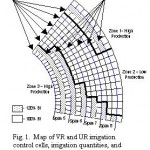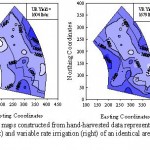(Field 5B)
James P. Bordovsky, Steve Jackson, Sally J. Officer, and Robert J. Lascano
Objective: The objective was to determine if cotton yields can be increased by planned, non-uniform distribution of irrigation thereby improving rainfall and irrigation use compared to standard irrigation methods.
Methodology: A field experiment was conducted to document potential advantages of variable rate (VR) irrigation of cotton over standard practices. Alternating strips of cotton, 20 to 22 rows wide, were irrigated by either VR or uniform-rate (UR) irrigation (Fig. 1). Within the VR strips, irrigation quantities were increased above the base rate in zones thought to be “more productive”. Soil electrical conductivity (EC) was used to determine productivity and, thus, delineate management zones on a 15.4-acre test area. Early season irrigations were uniform over the entire area. Irrigations after 16 July totaled 8.5 inches (~80% ET) in areas irrigated at the base level and 10.2 inches in the “more productive” areas within the VR strips. Cotton lint yields were sampled at multiple geo-referenced sites. Average lint yields were determined by integrating harvest data obtained at the 46 sites irrigated at the base level, this represented UR irrigation over the entire area. Average VR yield over this same area was determined by integrating similar data obtained at 49 sites that received both base and elevated irrigations as a function of soil EC.
Results: Using soil EC as the criterion to establish management zones, VR irrigation resulted in higher average lint yields than UR (Fig. 2), but at the cost of additional water inputs. Using yield data from the alternate treatment strips, VR yields were not significantly higher than UR yields. Water use efficiency was slightly higher in the UR that the VR treatments (104 verses 101 lb/ac-in, respectively). Preliminary results illustrate that in-season, site-specific water management of a cotton crop is complex.
(Click on images to enlarge)
- Fig. 1. Map of VR and UR irrigation control cells, irrigation quantities, and boundaries between management zones.
- Fig. 2. Yields maps constructed from hand-harvested data representing uniform irrigation (left) and variable rate irrigation (right) of an identical area at Helms Farm, 2002.



